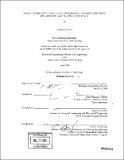Murine embryonic stem cells and hypoxia : growth kinetics, metabolism, and plating efficiency
Author(s)
St. Laurent, Daryl, 1979-
DownloadFull printable version (4.094Mb)
Other Contributors
Massachusetts Institute of Technology. Biological Engineering Division.
Advisor
Jean-François P. Hamel.
Terms of use
Metadata
Show full item recordAbstract
There is reason to believe that embryonic stem cells would grow favorably in a hypoxic environment. These cells come from the pre-implantation embryo, whose native environment is the hypoxic mammalian reproductive tract. Growing stem cells in an environment with higher oxygen levels (i.e. the atmospheric oxygen levels that are normally used to cultivate stem cells) could be bad for the cells, as oxygen is toxic due to its powerful oxidative capacity. In this experiment, J1 murine embryonic stem cells were grown at 0%, 2%, 5%, 10%, and 20% oxygen by volume to assess the effects that lower oxygen levels have on stem cell growth, plating efficiency, and metabolism. Two reaction vessels were built so that the cells could be grown in a controlled environment. Premixed gas cylinders were used to flush the vessels and an optical probe was used to measure the headspace oxygen concentration. Cells were found to grow faster than atmospheric conditions when in a moderately hypoxic environment where the oxygen concentration was between 2% and 10%, and considerably slower than atmospheric conditions as the headspace oxygen concentration approached zero. Maximum cell density decreased, glucose-lactate yield increased, glucose-cell yield decreased, and glutamine-cell yield decreased as headspace oxygen decreased. There were no strong correlations between oxygen concentration and glutamine-ammonia yield or plating efficiency. From the results of this study, it appears that it may be preferable to grow murine embryonic stem cells in a moderately hypoxic environment around 10% oxygen to increase the growth rate while minimizing the maximum cell density and metabolic inefficiency compromises.
Description
Thesis (M. Eng.)--Massachusetts Institute of Technology, Biological Engineering Division, 2004. "June 2004." Includes bibliographical references (p. 75-79).
Date issued
2004Department
Massachusetts Institute of Technology. Department of Biological EngineeringPublisher
Massachusetts Institute of Technology
Keywords
Biological Engineering Division.